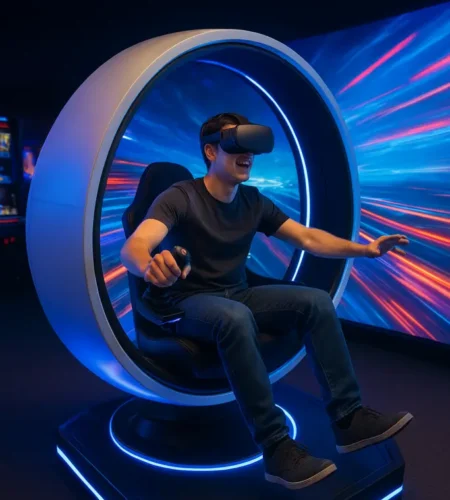Virtual reality is redefining entertainment, training, and interactive experiences, and 360-degree VR chairs are at the forefront of this transformation. These motion-enabled chairs allow users to engage fully with virtual environments, creating a level of immersion that goes beyond standard VR headsets.
For businesses aiming to provide memorable and engaging experiences, working with a trusted vr 360 chair manufacturer ensures access to high-quality, reliable systems. Whether for arcades, entertainment centers, or specialized simulation setups, 360-degree VR chairs offer thrilling motion, responsive controls, and ergonomic designs that enhance both user satisfaction and repeat engagement, making them a strategic investment for any venue.
The Importance of Immersive Seating
While VR headsets create impressive visual and auditory experiences, motion-enabled seating takes immersion a step further. Users feel acceleration, rotation, and other physical cues that mirror the virtual environment, which significantly enhances the sense of presence.
This physical feedback not only makes gameplay or simulations more engaging but also encourages longer sessions, as users feel fully “inside” the experience. For arcades and entertainment centers, this translates to higher visitor satisfaction and stronger customer loyalty.
Key Features of 360-Degree VR Chairs
Modern VR chairs offer a variety of features designed to deliver realistic and captivating experiences:
Motion Capabilities
360-degree rotation, pitch, roll, and yaw movements allow users to experience realistic motion in games and simulations. These chairs often include precise hydraulic or electric actuators that replicate turns, drops, and accelerations, creating a sensation similar to real-world experiences.
Ergonomic Design
Comfort is essential for extended VR sessions. Adjustable seats, supportive cushioning, and intuitive control layouts minimize fatigue and maximize user enjoyment. Ergonomically designed chairs ensure that the user can focus on the virtual environment rather than physical discomfort.
Software Compatibility
VR chairs that integrate seamlessly with a variety of simulation software allow venues to offer diverse experiences. From racing and flight simulations to adventure and roller-coaster games, this compatibility enhances the chair’s value and broadens its appeal to different audiences.
Haptic Feedback
Advanced haptic systems provide tactile sensations such as vibrations, impacts, and environmental effects. By simulating the feel of collisions, engine rumble, or turbulence, haptic feedback adds another layer of realism that keeps users engaged.
Customization and Adaptability
Many 360-degree VR chairs are modular, allowing operators to adjust components according to their needs. Interchangeable control panels, adjustable seat sizes, and configurable motion intensity make the chairs suitable for a wide range of users. This adaptability ensures that experiences can be tailored for casual gamers, thrill-seekers, or professional trainees.
Safety and Reliability
As motion-enabled chairs become more advanced, safety remains a top priority. Systems typically include secure seatbelts, automatic stop features, and motion limits to prevent injury. Partnering with a reputable VR 360 chair manufacturer guarantees that the chairs are built to high safety standards and include ongoing support for maintenance and updates, reducing downtime and protecting your investment.
Applications Across Industries
While arcades and entertainment centers are the most common venues for 360-degree VR chairs, their applications extend beyond gaming. Theme parks use them to simulate rides, training centers employ them for pilot or vehicle training, and corporate environments leverage them for team-building exercises. The versatility of VR chairs creates opportunities for businesses to diversify offerings and attract a wide range of customers.
Enhancing Customer Engagement
360-degree VR chairs encourage repeat visits through their immersive nature. Features like multiplayer modes, leaderboards, and competitive scenarios increase engagement, while custom experiences tailored to different audiences provide novelty and excitement. By offering memorable experiences, businesses can differentiate themselves in a competitive entertainment market.
Looking Ahead
The future of VR seating technology promises even greater realism and interactivity. Advancements may include smarter motion algorithms, integration with augmented reality elements, and AI-driven personalization that adjusts motion and feedback based on user preferences. Venues that adopt these innovations early can position themselves as leaders in immersive entertainment.
Conclusion
360-degree VR chairs are more than just an entertainment device—they are a tool for creating unforgettable experiences. By combining motion, haptic feedback, ergonomic design, and software versatility, these chairs transform virtual experiences into fully immersive interactions.
For businesses, investing in high-quality systems from a trusted VR 360 chair manufacturer enhances customer satisfaction, encourages repeat visits, and opens new revenue opportunities. The integration of 360-degree VR chairs ensures that your venue stays at the forefront of interactive entertainment, offering experiences that captivate and engage every visitor.
Also Read-


Comments